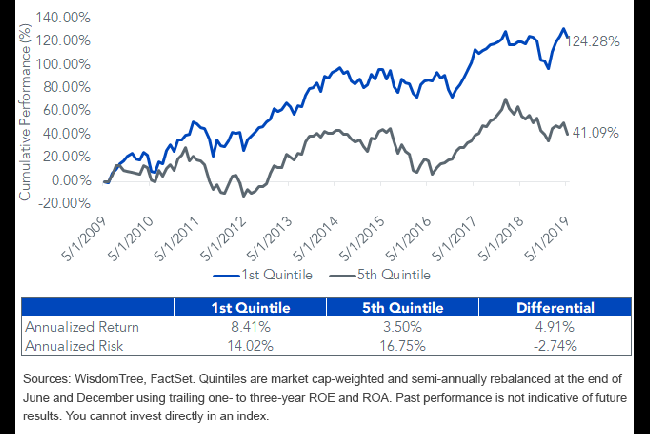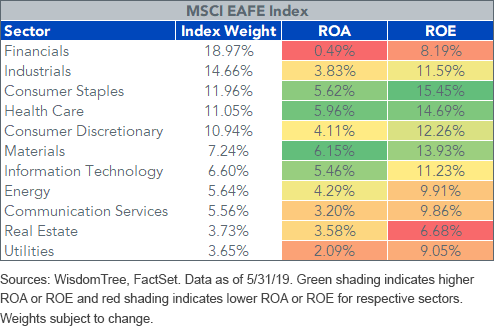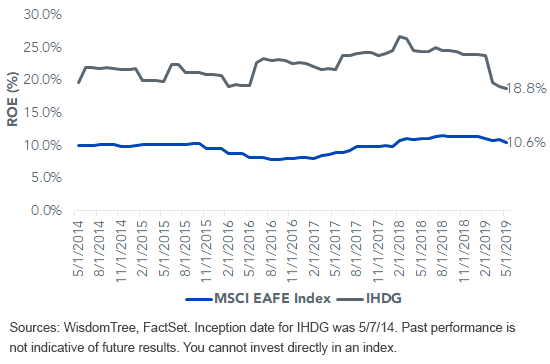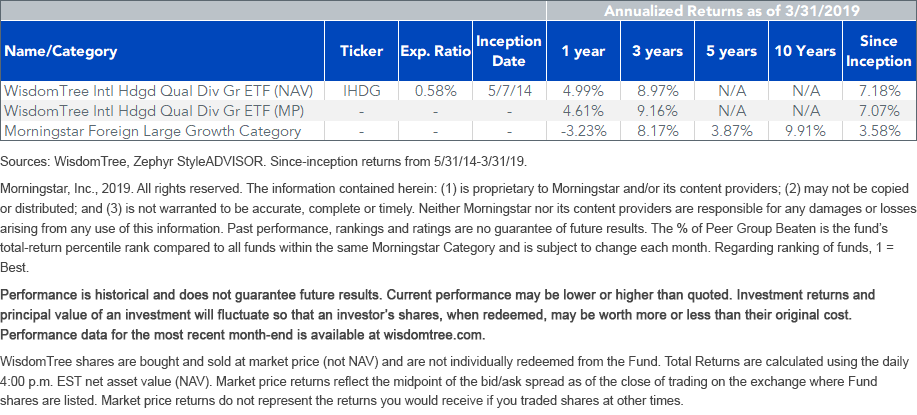A Quality Decade for International Equities


Growth has outperformed value globally for the last decade. It’s been a significant headwind for rules-based (“quant”) strategies targeting less expensive stocks.
During this rough period, quants have paid increasing attention to “quality” companies.
Quality has a variety of definitions—as should all robust factors—but typically includes measures of profitability and leverage.
By screening profits, quality is closely related to growth, providing a good hedge to value or an attractive overlay to a value-tilted strategy1.
Due to the strong performance of quality strategies—and the resilience of the factor during times of market volatility—capital has flowed into quality-focused funds this year.
WisdomTree has been an industry leader: Our currency-hedged approach to quality in broad developed international ranks in the top 5% of its Morningstar category since its inception.2
Quality Outperformance in Developed International Markets
A lot of factor discussions are U.S.-centric, but quality has had a significant performance advantage in developed international markets.
Below, we chart the performance of the first and fifth quintiles of constituents from the MSCI EAFE Index scored by a combination of return on equity (ROE) and return on assets (ROA). ROE is a good measure of the profits generated on the capital provided by common stockholders, while including ROA provides a check on the leverage financing that may be juicing ROE.
The highest quality quintile outperformed the lowest by nearly 500 basis points (bps) annualized, and at 274 bps of lower volatility.
MSCI EAFE Quintiles of Return on Equity and Return on Assets (5/31/09-5/31/19)

A cap-weighted index gives no consideration to fundamentals like profitability in its composition. The Financials sector dominates the MSCI EAFE Index, with nearly a 19% weight, due to the market having over 100 mid-sized national banks that are fighting for market share and profitability.

The WisdomTree Quality Approach
Five years ago, WisdomTree launched the WisdomTree International Hedged Quality Dividend Growth Fund (IHDG). It screens for quality dividend-paying companies. The main measures for quality are trailing three-year ROE and three-year ROA. The result is a Fund that has had, on average, about twice as high a ROE than the MSCI EAFE Index.
Return on Equity (5/31/14 – 5/31/19)

As of May 31, 2019, the Fund held just under 4% of its weight in Financials. Its biggest sector over-weights are in Consumer Discretionary, Industrials, Health Care, and Information Technology.
Since its inception, IHDG has outperformed the average returns of its peers in the Morningstar Foreign Large Growth Category, as well as both the MSCI EAFE Local Currency and MSCI EAFE Indexes.
Part of this outperformance is explained by its currency hedge during a strong dollar environment—evident by the outperformance of the MSCI EAFE Local Currency Index over the unhedged MSCI EAFE Index. But it has also benefited from its over-weight to quality companies.

For definitions of terms in the chart, please visit our glossary.
Conclusion
Many U.S. investors actively monitor factor exposures for their domestic equity allocations, but then default to an unhedged market cap-weighted allocation or unhedged active manager for their international exposure.
We have long argued the merits of at least partial hedging in international equities, in order to improve the risk-return profile by mitigating some of the embedded currency bet. And just as investors are familiar with harvesting the quality risk-premium in U.S. equities in a rules-based ETF, we would argue investors should consider doing so in developed international markets as well.

1Novy-Marx, Robert. (2013). “The Other Side of Value: The Gross Profitability Premium,” Journal of Financial Economics, 108, issue 1, p. 1-28.
2Sources: Morningstar, WisdomTree, 5/31/14-3/31/19. Inception date for IHDG was 5/7/14. There are 320 investments included in peer group for Morningstar Foreign Large Growth. The percentile rank is the funds' total-return percentile rank compared to all funds within the same Morningstar category and is subject to change each month. There are 320 investments included in peer Foreign Large Growth Category , for since inception performance, 5/31/14-3/31/19. For the one year period as of 3/31/19 the fund is in the 7 rank out of 442 funds.
Important Risks Related to this Article
There are risks associated with investing, including possible loss of principal. Foreign investing involves special risks, such as risk of loss from currency fluctuation or political or economic uncertainty. To the extent the Fund invests a significant portion of its assets in the securities of companies of a single country or region, it is likely to be impacted by the events or conditions affecting that country or region. Dividends are not guaranteed and a company currently paying dividends maay cease paying dividends at any time. Investments in currency involve additional special risks, such as credit risk and interest rate fluctuations. Derivative investments can be volatile, and these investments may be less liquid than other securities, and more sensitive to the effect of varied economic conditions. As this Fund can have a high concentration in some issuers, the Fund can be adversely impacted by changes affecting those issuers. The Fund invests in the securities included in, or representative of, its Index regardless of their investment merit and the Fund does not attempt to outperform its Index or take defensive positions in declining markets. Due to the investment strategy of this Fund, it may make higher capital gain distributions than other ETFs. Please read the Fund’s prospectus for specific details regarding the Fund’s risk profile.
The Global Industry Classification Standard (“GICS”) was developed by and is the exclusive property and a service mark of MSCI Inc. (“MSCI”) and Standard & Poor’s (“S&P”), a division of The McGraw-Hill Companies, Inc., and is licensed for use by WisdomTree Investments, Inc. Neither MSCI, S&P nor any other party involved in making or compiling the GICS or any GICS classifications makes any express or implied warranties or representations with respect to such standard or classification (or the results to be obtained by the use thereof), and all such parties hereby expressly disclaim all warranties of originality, accuracy, completeness, merchantability and fitness for a particular purpose with respect to any such standard or classification. Without limiting any of the foregoing, in no event shall MSCI, S&P, any of their affiliates or any third party involved in making or compiling the GICS or any GICS classifications have any liability for any direct, indirect, special, punitive, consequential or any other damages (including lost profits), even if notified of the possibility of such damages.


